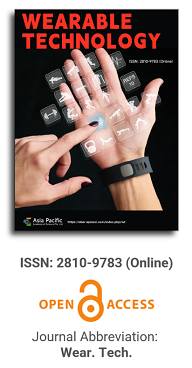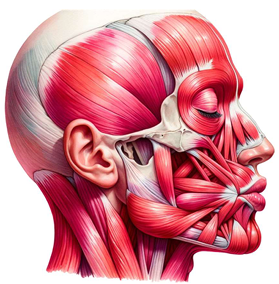

This paper delves deeply into the innovative realm of integrating human emotions with wearable technology. The primary focus is on the conceptualization and development of a kiss transfer device that harnesses the power of wearable technology to bridge the physical gap in human-human interactions. By investigating the intricate nuances of the human-human kissing process, the research seeks to replicate this intimate gesture through a technological medium. The paper not only elaborates on the anatomy, evolution, and hormonal dynamics of kissing but also underscores the transformative potential of wearable technology in capturing and transmitting these intimate moments. This exploration opens up new horizons for long-distance relationships, offering a tangible touchpoint that goes beyond traditional communication methods. Through this pioneering work, the research positions wearable technology as not just a tool for communication but as an extension of our human emotions and expressions.

Influence of diet and exercise adherence in diabetic cases and its impact on HbA1c
Vol 4, Issue 1, 2023
Download PDF
Abstract
In a current cross-sectional experimental study, it was observed that the impact of diet and exercise on healthy life adherence in mature diabetes cases and their influence on glycated hemoglobin (HbA1c, average glucose) The diabetic patients (male and female) were anatomized in relation to adherence and suggested a diet with exercise plans that control the adverse effect of producing less insulin. A sample of 30 subjects, 30–50 years old, were selected randomly from 3 major hospitals (Jinnah, Mayo, and Services) and some private laboratories. A group of normal control subjects (N = 10) was also selected for further comparison. The HbA1c test has been taken before and after the implementation of the 12-week diet and exercise plan. This study utilized a simple random sampling technique, and normality was checked through the Shapiro-Wilk test. The data was analyzed through SPSS-22, and a paired sample t-test was utilized for further comparison. The lower HbA1c values indicate a better diabetes operation. These results clearly depicted that it controlled the worse effects of sugar patients, which also emphasizes the significance of adherence in achieving optimal glycaemic control. The result also concluded that a balanced diet and a combination of exercises control the glycaemic patients efficiently and effectively.
Keywords
References
- Qi Q, Meigs JB, Rexrode KM, et al. Diabetes genetic predisposition score and cardiovascular complications among patients with type 2 diabetes. Diabetes Care 2013; 36(3): 737–739. doi: 10.2337/dc12-0852
- Li M, Su L, Liang B, et al. Trends in prevalence, awareness, treatment, and control of diabetes mellitus in mainland China from 1979 to 2012. International Journal of Endocrinology 2013; 2013: 1–14. doi: 10.1155/2013/753150
- Abbas K, Gill SA, Sherwani RAK, et al. Prevalence of obesity and trends of body mass index in Azad Jammu and Kashmir. Journal of Pharmaceutical Research International 2021; 33(15): 69–82. doi: 10.9734/jpri/2021/v33i1531289
- Zimmet P, Alberti KGMM, Shaw J. Global and societal implications of the diabetes epidemic. Nature 2001; 414(6865): 782–787. doi: 10.1038/414782a
- Sena CM, Bento CF, Pereira P, Seiça R. Diabetes mellitus: New challenges and innovative therapies. EPMA Journal 2010; 1(1): 138–163. doi: 10.1007/s13167-010-0010-9
- Habib F. Effect of age and socio-economic status on compliance among Type 2 diabetic patients. Current Research in Diabetes & Obesity Journal 2018; 7(3): 555714. doi: 10.19080/crdoj.2018.07.555714
- Gill SA, Bilal M, Akhtar MS. Effects of Covid-19 (obesity): Result of imbalance nutrition and physical inactivity during Covid-19 (athletes and non-athletes). Human Nature Journal of Social Sciences 2023; 4(2): 245–253.
- Ahmed AM. History of diabetes mellitus. Saudi Medical Journal 2002; 23(4): 373–378.
- Introduction: Standards of medical care in diabetes—2021. Diabetes Care 2020; 44(Supplement_1): S1–S2. doi: 10.2337/dc21-sint
- Whiteley C, Benton F, Matwiejczyk L, Luscombe-Marsh N. Determining dietary patterns to recommend for Type 2 diabetes: An umbrella review. Nutrients 2023; 15(4): 2–18. doi: 10.3390/nu15040861
- Habib F, Durrani AM. Self-care behaviour and well-being of diabetic patients. Indian Journal of Health & Wellbeing 2015; 6(12): 1268.
- Christensen J, Valentiner LS, Petersen RJ, Langberg H. The effect of game-based interventions in rehabilitation of diabetics: A systematic review and meta-analysis. Telemedicine and e-Health 2016; 22(10): 789–797. doi: 10.1089/tmj.2015.0165.
- Gill SA, Saddiqa A, Abdullah U, et al. Diagnosis, treatment & rehabilitation of rotator cuff acute & chronic injury in throwing sports athletes by isometric, isotonic and theraband exercises. Journal of Pharmaceutical Research International 2022; 34(60): 12–20. doi: 10.9734/jpri/2022/v34i607270
- Shaji SP. Cardiac rehabilitation: The vital role of nurses in cardiothoracic patient recovery. EPRA International Journal of Multidisciplinary Research 2023; 9(9): 1–4.
- Conway CM, Kelechi TJ. Digital health for medication adherence in adult diabetes or hypertension: An integrative review. JMIR Diabetes 2017; 2(2): e20. doi: 10.2196/diabetes.8030
- Gill SA, Bilal M, Maqsood M. Effects of stretching exercises on cricket wicket keeper performance and reduction of injury rate. Human Nature Journal of Social Sciences 2023; 4(2): 560–568.
- Boath A, Vale L, Hayes L, et al. Differential effects of diet and physical activity interventions in pregnancy to prevent gestational diabetes mellitus and reduce gestational weight gain by level of maternal adiposity: A protocol for an individual patient data (IPD) meta-analysis of randomised controlled trials. BMJ Open 2023; 13(3): e065335. doi: 10.1136/bmjopen-2022-065335
- World Health Organization. Diabetes. Available online: https://www.who.int/health-topics/diabetes#tab=tab_1 (accessed on 3 January 2024).
- Ayoobi F, Salari Sedigh S, Khalili P, et al. Dyslipidemia, diabetes and periodontal disease, a cross-sectional study in Rafsanjan, a region in southeast Iran. BMC Oral Health 2023; 23(1): 549. doi: 10.1186/s12903-023-03262-x
- Yadegar A, Mohammadi F, Rabizadeh S, et al. Decreasing trend of blood lipid profile in type 2 diabetes: Not a promising change in HDL-C, a serial cross-sectional study. PLoS One 2023; 18(10): e0293410. doi: 10.1371/journal.pone.0293410
- Xu X, Yang W, Deng Y, et al. Association of socioeconomic status with glycated haemoglobin level and risk factors for diabetic retinopathy: A cross-sectional study in Sichuan, western China. BMJ Open 2023; 13(2): e067475. doi: 10.1136/bmjopen-2022-067475
- Chen Q, Carbone ET. Functionality, implementation, impact, and the role of health literacy in mobile phone apps for gestational diabetes: Scoping review. JMIR Diabetes 2017; 2(2): e25. doi: 10.2196/diabetes.8045
- Young KG, McGovern AP, Barroso I, et al. The impact of population-level HbA1c screening on reducing diabetes diagnostic delay in middle-aged adults: A UK Biobank analysis. Diabetologia 2022; 66(2): 300–309. doi: 10.1007/s00125-022-05824-0
Supporting Agencies
Copyright (c) 2024 Minahil Maqsood, Muhamamd Sajjad Ali Gill, Irshad Nabi, Muhamamd Umer, Muhammad Imran, Rana Adil, Ayesha Sajjad, Aqib Liaqat, Sajjad Aslam, Hira Shahid

This work is licensed under a Creative Commons Attribution 4.0 International License.

Prof. Zhen Cao
College of Information Science & Electronic Engineering, Zhejiang University
China, China
Processing Speed
-
-
-
- <5 days from submission to initial review decision;
- 62% acceptance rate
-
-
Asia Pacific Academy of Science Pte. Ltd. (APACSCI) specializes in international journal publishing. APACSCI adopts the open access publishing model and provides an important communication bridge for academic groups whose interest fields include engineering, technology, medicine, computer, mathematics, agriculture and forestry, and environment.





